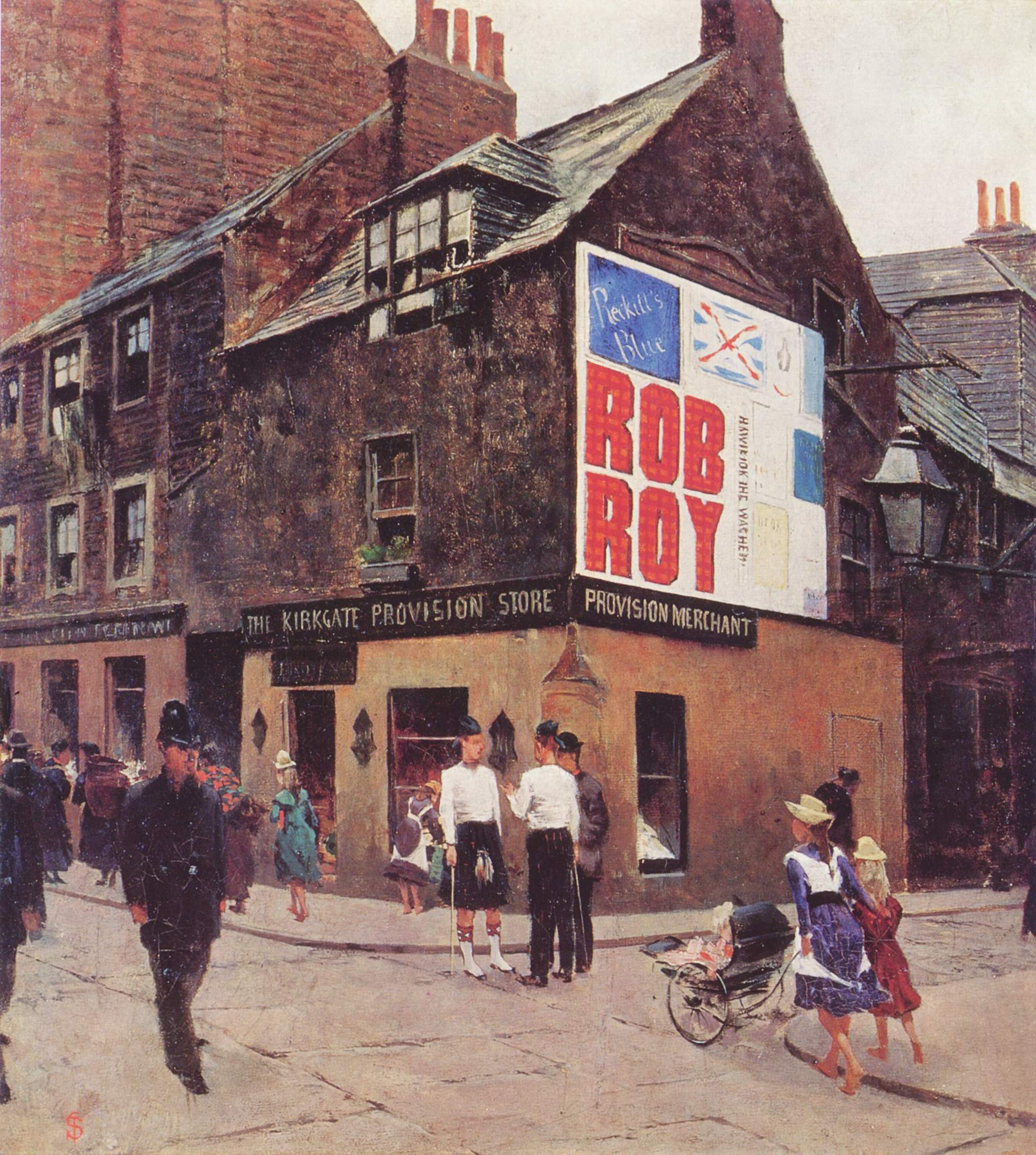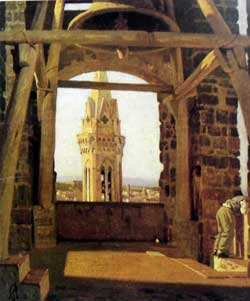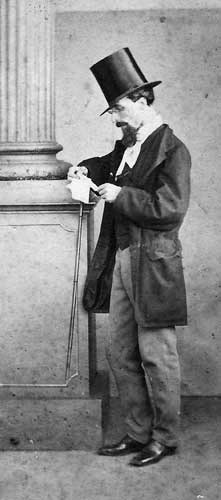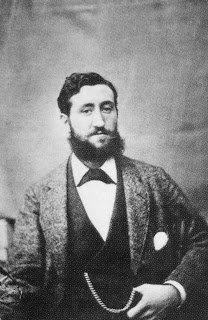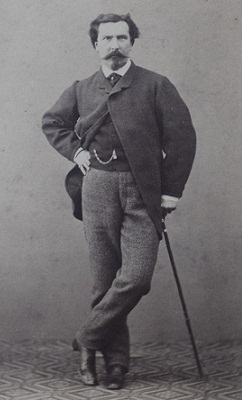|
Macchiaioli
The Macchiaioli () were a group of Italian painters active in Tuscany in the second half of the nineteenth century. They strayed from antiquated conventions taught by the Italian art academies, and did much of their painting outdoors in order to capture natural light, shade, and colour. This practice relates the Macchiaioli to the French Impressionists who came to prominence a few years later, although the Macchiaioli pursued somewhat different purposes. The most notable artists of this movement were Giuseppe Abbati, Cristiano Banti, Odoardo Borrani, Vincenzo Cabianca, Adriano Cecioni, Vito D'Ancona, Serafino De Tivoli, Giovanni Fattori, Raffaello Sernesi, Silvestro Lega and Telemaco Signorini. The movement The movement originated with a small group of artists, many of whom had been revolutionaries in the uprisings of 1848. In the late 1850s, the artists met regularly at the Caffè Michelangiolo in Florence to discuss art and politics. These idealistic young men, dissatisfied ... [...More Info...] [...Related Items...] OR: [Wikipedia] [Google] [Baidu] |
Giovanni Fattori
Giovanni Fattori (September 6, 1825August 30, 1908) was an Italian artist, one of the leaders of the group known as the Macchiaioli. He was initially a painter of historical themes and military subjects. In his middle years, inspired by the Barbizon school, he became one of the leading Italian plein-airists, painting landscapes, rural scenes, and scenes of military life. After 1884, he devoted much energy to etching. Biography Youth and training Fattori was born in modest circumstances in Livorno. His early education was rudimentary and his family initially planned for him to study for a qualification in commerce, but his skill in drawing persuaded them to apprentice him in 1845 to Giuseppe Baldini (1807–1876), a local painter of religious themes and genre subjects. The following year he moved to Florence where he first studied under Giuseppe Bezzuoli and, later in the year, at the Academy of Fine Arts in Florence. At that time, however, his energies were directed less towa ... [...More Info...] [...Related Items...] OR: [Wikipedia] [Google] [Baidu] |
Telemaco Signorini
Telemaco Signorini (; August 18, 1835 – February 10, 1901) was an Italian artist who belonged to the group known as the Macchiaioli. Biography He was born in the Santa Croce quarter of Florence, and showed an early inclination toward the study of literature, but with the encouragement of his father, Giovanni Signorini (1808–1864), a court painter for the Grand Duke of Tuscany, he decided instead to study painting.Steingräber, E., & Matteucci, G. 1984, p. 115 In 1852 he enrolled at the Florentine Academy, and by 1854 he was painting landscapes en plein air. The following year he exhibited for the first time, showing paintings inspired by the works of Walter Scott and Machiavelli at the Società Promotrice delle Belle Arti. In 1855, he began frequenting the Caffè Michelangiolo in Florence, where he met Giovanni Fattori, Silvestro Lega, Saverio Altamura and several other Tuscan artists who would soon be dubbed the Macchiaioli. The Macchiaioli, dissatisfied with th ... [...More Info...] [...Related Items...] OR: [Wikipedia] [Google] [Baidu] |
Giuseppe Abbati
Giuseppe Abbati (January 13, 1836February 21, 1868) was an Italian painter who belonged to the group known as the Macchiaioli. Biography Abbati was born in Naples. He received early training in painting from his father Vincenzo, who specialized in paintings of architectural interiors, and Abbati's own early paintings were interiors.Broude 1987, p. 80. He participated in Garibaldi's 1860 campaign, suffering the loss of his right eye at the Battle of Capua. Afterwards he moved to Florence where, at the Caffè Michelangiolo, he met Giovanni Fattori, Silvestro Lega, and the rest of the artists who would soon be dubbed the Macchiaioli.Steingräber & Matteucci 1984, p. 103. At the National Exposition in Florence in 1861, Abbati was awarded a medal for his interior views—but refused to accept it, as a gesture of protest against the composition of the jury. Subsequently, he became attracted to the practice of painting landscapes ''en plein air''. His activity as a painter was interru ... [...More Info...] [...Related Items...] OR: [Wikipedia] [Google] [Baidu] |
Vincenzo Cabianca
Vincenzo Cabianca (June 21, 1827, Verona – March 21, 1902, Rome) was an Italian painter of the Macchiaioli group. Biography He was born in Verona in modest circumstances. He began his artistic training at the Verona Academy under Giovanni Caliari, and then studied at the Venice Academy from 1845 to 1847.Steingräber, E., & Matteucci, G. 1984, p. 107. An admirer of Giuseppe Mazzini, he became associated with the Young Italy (historical), Young Italy movement and was taken prisoner while participating in the defense of Bologna in 1848. After his release he lived in Venice from 1849 until 1853. During the 1850s Cabianca became acquainted with the artists, including Adriano Cecioni, Cristiano Banti, and Telemaco Signorini, who frequented the Caffè Michelangiolo in Florence, who would be known as the Macchiaioli. He became a friend of Signorini, and travelled with Signorini and Banti to Paris. His friend's influence led Cabianca to turn away from Genre art, genre paintings toward ... [...More Info...] [...Related Items...] OR: [Wikipedia] [Google] [Baidu] |
Caffè Michelangiolo
Caffè Michelangiolo was a historic café in Florence, located in Via Larga (now renamed Via Cavour). During the nineteenth century Wars of Italian Independence, it became a major meeting place for Tuscan writers and artists, and for patriots and political exiles from other Italian states.Caffè Michelangiolo Anno I – N. 1, Gennaio–Aprile 1996 , mauropagliai.it. The Caffè, which existed from 1848 to 1866, was frequented by the artists of the , especially after 1855.Broude 1987, p. 52 One of the artists, |
Silvestro Lega
Silvestro Lega (8 December 1826 – 21 September 1895) was an Italian Realism (art), realist painter. He was one of the leading artists of the Macchiaioli and was also involved with the Mazzini movement. Biography He was born in Modigliana, near Forlì, to an affluent family. From 1838 he attended the Piarist College, where his skill at drawing became evident. From 1843 to 1847 he attended the Accademia di Belle Arti, Florence, studying drawing under Benedetto Servolini (1805–79) and Tommaso Gazzarrini (1790–1853), then studying painting, briefly, under Giuseppe Bezzuoli. During 1847 he attended Luigi Mussini’s school, where the teaching emphasized the 15th-century Florence, Florentine principles of drawing and orderly construction. Then and for some years afterwards he continued to attend the Scuola del Nudo of the Accademia. As a Garibaldian volunteer, Lega participated in the military campaigns for Italian independence (1848–49) before resuming his training, this time ... [...More Info...] [...Related Items...] OR: [Wikipedia] [Google] [Baidu] |
Serafino De Tivoli
Serafino De Tivoli (March 18261892) was an Italian painter of the Macchiaioli group. Biography He was born in Livorno. After initial study of literature at a religious private school in Florence, he began his artistic training under Carlo Markò the Elder. He met Vito D'Ancona during the mid-1840s, and joined him in painting landscapes ''en plein air''. In 1848 he fought as a Tuscan volunteer for Garibaldi in the Risorgimento. In 1855 his paintings, exhibited at the Florentine Promotrice exhibition, brought him to the attention of the artists who frequented the Caffè Michelangiolo in Florence (including those who would later become known as the Macchiaioli). In that same year he traveled to Paris, where he was greatly impressed by the paintings of the Barbizon school. He saw in their realism and powerful chiaroscuro a means of renewing art in the modern age. Upon his return to Florence he conveyed this new enthusiasm to his friends, who quickly adopted his ideas. In recogniti ... [...More Info...] [...Related Items...] OR: [Wikipedia] [Google] [Baidu] |
Cristiano Banti
Cristiano Banti (4 January 1824 – 4 December 1904) was an Italian genre and landscape painter. He was a leading figure in the Macchiaioli movement of Tuscany. Biography Banti was born into a middle-class family in Santa Croce sull'Arno. A scholarship enabled him to study at the with Francesco Nenci. At this time, he worked in the Neo-Classical style and produced what is perhaps his best-known work, ''Galileo Facing the Inquisition''.Biographical notes from the ''Enciclopedia Italiana'' by Nello Tarchiani @ . [...More Info...] [...Related Items...] OR: [Wikipedia] [Google] [Baidu] |
Vito D'Ancona
Vito D'Ancona (August 12, 1825January 9, 1884) was an Italian painter of the Macchiaioli group. He was born in Pesaro to a wealthy Jewish family. He began his artistic training in Florence, and in 1844 was admitted to the Accademia di Belle Arti, where he studied under Giuseppe Bezzuoli. He became friends with Serafino De Tivoli, and joined him in painting landscapes ''en plein air''. In 1848 he fought as a Tuscan volunteer for Garibaldi in the Risorgimento. During the 1850s he became acquainted with the artists who frequented the Caffè Michelangiolo in Florence, who would soon be known as the Macchiaioli. D'Ancona achieved success as a portrait painter, and few of his landscape paintings can be traced today.Steingräber, E., & Matteucci, G. 1984, p. 69. His ''Woman at the Races'' (ca. 1873) reveals the influence of Japonisme he had absorbed while living in Paris between 1867 and 1874. Suffering from the effects of syphilis, D'Ancona's health disintegrated in the mid-1870s, an ... [...More Info...] [...Related Items...] OR: [Wikipedia] [Google] [Baidu] |
Raffaello Sernesi
Raffaello Sernesi (December 25, 1838 – August 9, 1866) was an Italian painter and medallist associated with the Macchiaioli group. He was born in Florence in modest circumstances. After an apprenticeship to a local engraver, he enrolled at the Accademia of Florence in 1856, where he studied under Antonio Ciseri.Steingräber & Matteucci 1984, p. 114. As part of his training he made copies of the works of quattrocento artists such as Masaccio and Botticelli.Broude 1987, p. 78. In 1858 his father died, and Sernesi left the Academy in order to help support his family as an engraver and medallist. In 1859 he began frequenting the Caffè Michelangiolo and met the artists of the Macchiaioli, including Odoardo Borrani, who became a close friend. Sernesi served as a volunteer in the Second Italian War of Independence in 1859. Upon his return to Florence later that year, he made his first plein air landscape paintings.Broude 1987, p. 79. Norma Broude says these works are characterized ... [...More Info...] [...Related Items...] OR: [Wikipedia] [Google] [Baidu] |
Odoardo Borrani
Odoardo Borrani (22 August 1833 – 14 September 1905) was an Italian painter associated with the Macchiaioli group. Biography He was born in Pisa. The Borrani family moved to Florence, where Odoardo enrolled at the Academy of Fine Arts in 1853. There, he studied under , Giuseppe Bezzuoli, and Enrico Pollastrini. However, he became independent of the academic styles. His first painting while at the Academy was titled ''Un veglione di maschere alla Pergola''. In 1859, he painted ''Lorenzo the Magnificent Saves Himself From Being Murdered in the Sacristy of the Cathedral'', an episode of the Pazzi Conspiracy. For this painting. Borrani was awarded the Gold medal by the contest of the Accademia of Florence. That same year, he joined the army and upon returning from the short campaign, he painted the ''Cadaver of Jacopo de' Pazzi'' and ''Michelangelo Directs the Fortification of Florence''. It was with his new friends Telemaco Signorini and Vincenzo Cabianca that he took up paintin ... [...More Info...] [...Related Items...] OR: [Wikipedia] [Google] [Baidu] |
Adriano Cecioni
Adriano Cecioni (July 26, 1836May 23, 1886) was an Italian artist, caricaturist, and critic associated with the Macchiaioli group. Biography He was born in Florence into a middle-class family belonging to the local gentry. He began his artistic training in 1859 at the Florentine Academy under the sculptor Aristodemo Costoli. In that same year he fought alongside Telemaco Signorini in the Second Italian War of Independence.Steingräber & Matteucci 1984, p. 108 In 1860 he participated in a competition to provide military artworks for the Tuscan government. His submission, a maquette for a statue of Charles Albert of Savoy, won a prize but was deemed unsatisfactory by academicians and was not commissioned.Oxford Art Online In 1863 Cecioni received a grant and went to Naples, where he was instrumental in the formation of the artists' group '' Scuola di Resina'', which included Giuseppe De Nittis, Marco de Gregorio, and Federico Rossano. A major work of this period was his sculptur ... [...More Info...] [...Related Items...] OR: [Wikipedia] [Google] [Baidu] |
